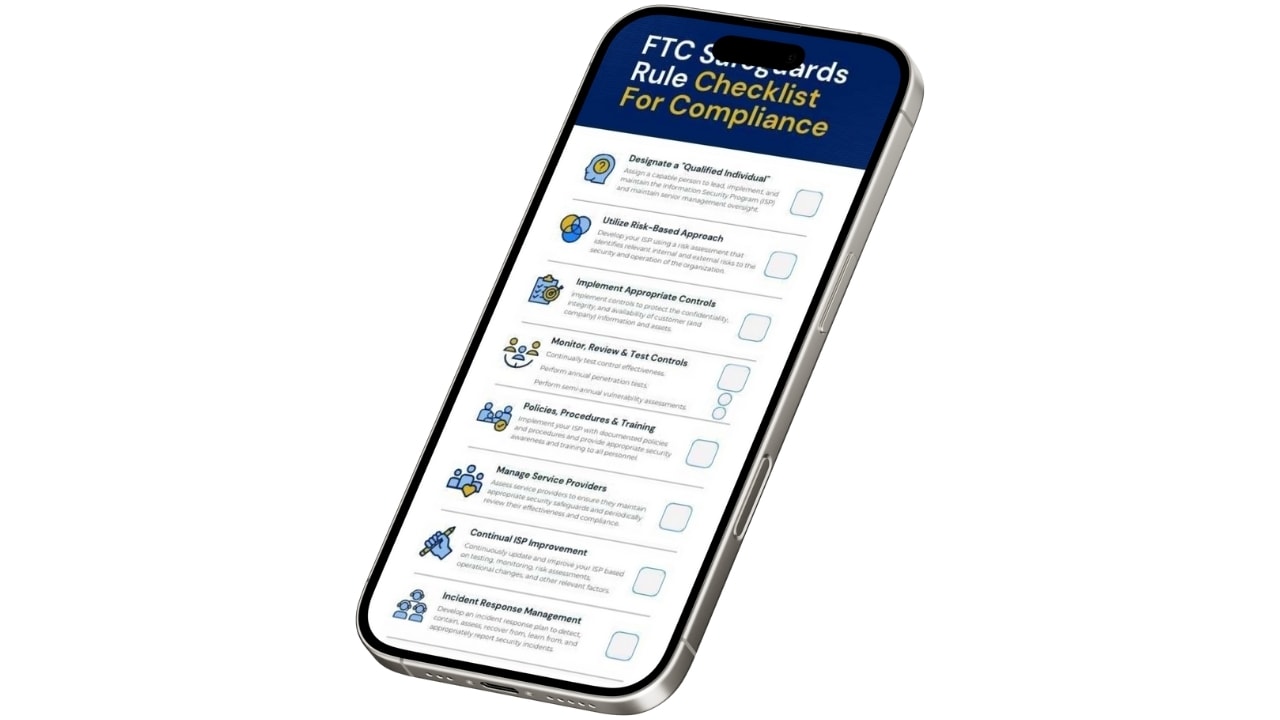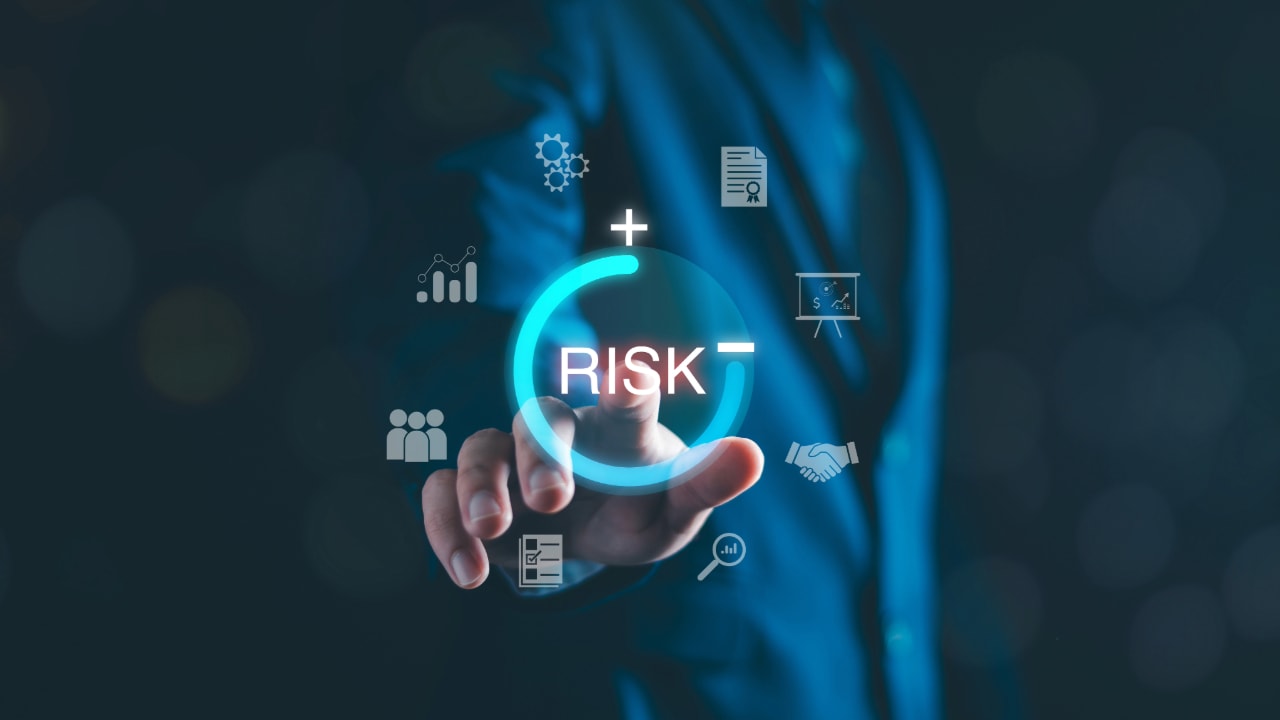FTC Safeguards Rule Checklist: Reporting to Senior Management
May 01, 2025
Welcome back to the final stop on our FTC Safeguards Rule road trip. If you’ve been with us since we first cracked open the compliance checklist, welcome back—stretch those legs and refill your coffee. If you’re just joining, don’t worry, the engine’s still warm.
Our series has unpacked every regulatory checkpoint like a security consultant with a carry-on full of policies, and now we’ve reached the final (but not to be ignored) destination: Reporting to Senior Management. This piece isn’t just about ticking boxes—it’s about translating cyber-speak into boardroom value.
Keep Pace with the FTC Safeguards Rule Checklist for Compliance Series Infographic

You’ve made it to the final leg of our FTC Safeguards Rule series—where regulatory fine print meets real-world application. If your idea of a good time involves audit prep, security frameworks, and more tabs open than your browser can handle, you’re in the right place.
These updated FTC requirements don’t just set expectations—they spell out what a solid cybersecurity program looks like in today’s high-risk, tech-heavy environment. From building an information security plan to executing it with precision, we’ve been breaking it all down checkpoint by checkpoint.
To make things even easier, we’ve created a sleek, no-nonsense FTC Safeguards Rule Checklist Infographic. It's also what our entire blog and podcast series is based on - we cover every single step.
👉 Download the FTC Safeguards Rule Checklist For Compliance Infographic
What Is the FTC Safeguards Rule Again?
The Federal Trade Commission's (FTC) Safeguards Rule, born from the Gramm-Leach-Bliley Act (GLBA) in 2003 and revamped in 2021, is a regulation that requires financial institutions to implement robust, measurable cybersecurity practices. These practices are designed to protect nonpublic personal information (NPI) and demonstrate accountability across your organization.
Why the refresh? Because the impact and cost of data breaches is skyrocketing. Today, a single misconfigured cloud bucket could cost millions.
The Rule’s updated requirements provide clarity and structure on what a “reasonably designed” information security program looks like—from risk assessments and incident response to (you guessed it) reporting up to leadership.
Who Must Comply? (Spoiler: Probably You)
The term “financial institution” is broader than you might think. It includes entities engaged in such financial activities. If your business deals in:
-
Tax preparers
-
Accounting services
-
Auto financing
-
Mortgage brokering
-
Credit repair
-
Property appraisal
-
Payday lending
-
Non-SEC investment advice
…you’re in. If you collect or handle financial information, the FTC expects you to play by the Rule’s playbook.
The Core Components of FTC Safeguards Rule Compliance

If you’re aiming to keep your organization aligned with the FTC’s expectations—and off its enforcement radar—your information security program needs to hit a well-defined set of regulatory targets. The Safeguards Rule lays out these essentials as the backbone of a compliant cybersecurity strategy:
-
Designate a qualified individual to lead your security efforts (§314.4(a))
Every program needs a captain. This person is responsible for developing, implementing, and maintaining your overall strategy. -
Develop a security plan that’s grounded in risk (§314.4(b))
Not all threats are created equal. Your approach should be based on what’s most likely—and most damaging—for your organization. -
Deploy safeguards that match the risks you’ve identified (§314.4(c))
It's not enough to know where the cracks are—you need to fix them with appropriate controls. -
Test, monitor, and tune your safeguards regularly (§314.4(d))
Static security is obsolete security. Keep your controls fresh through continuous monitoring and validation. -
Train your team so humans don’t become the weakest link (§314.4(e))
Cybersecurity is everyone’s job. Ongoing employee awareness training is non-negotiable. -
Assess and secure the partners you rely on (§314.4(f))
Third-party vendors are an extension of your attack surface. Manage them like your own systems. -
Refine your program as threats, tech, and business needs evolve (§314.4(g))
Complacency is a compliance killer. Your security program should never stand still. -
Prepare an incident response plan for when—not if—things go wrong (§314.4(h))
Disaster doesn’t wait for documentation. A well-rehearsed response plan is critical.-
Communicate breaches to regulators and customers where required
Transparency isn’t just good practice—it’s often the law.
-
-
Report your program’s status to senior leadership every year (§314.4(i)) <-- We are here!
Security doesn’t stop at the server room. Your board needs visibility and insight into how the program is performing.
§314.4(i) Reporting to Senior Management: What It Means
Section §314.4(i) of the Safeguards Rule requires organizations to deliver a written report to their board of directors or governing body at least annually. If no board exists, the report should go to the senior officer responsible for your information security program.
Organizations must implement procedures to ensure compliance with the Rule.
What this report must include:
-
The status of your information security program
-
Your organization’s compliance with the Rule
-
A summary of risk assessments and findings
-
Information about security events or incidents
-
Recommendations for addressing identified issues and improving controls
Why It Matters
Think of this report as your cybersecurity pitch deck for the C-suite. It’s a chance to showcase wins, highlight challenges, and secure the support you need. Setting clear security expectations is crucial for building organizational awareness. Done right, this process drives strategic investment and makes security a shared responsibility—not just an IT silo.
Best Practices for Reporting: A Practical Framework

Translating the guts of your cybersecurity program into something a board can act on is both an art and a science. These best practices follow the proven structure of Input Output’s ISP Management Review framework while also focusing on clarity, strategy, and accessibility—because the C-suite doesn’t need a syslog dump, they need insight.
Each section below offers practical, actionable guidance for how to craft board-level reports that tell a compelling story about your security program’s status, maturity, and next steps. The report should clearly demonstrate the company's compliance with the Safeguards Rule, ensuring that all regulatory requirements are met and effectively communicated.
1. Review Prior Action Items
Start with a review of what you said you’d do last time. This could include remediating a gap identified during an audit, implementing a new training initiative, improving a vendor onboarding process, or reviewing the progress of initiatives related to the information system. Use this section to demonstrate progress—or explain any blockers preventing completion.
Showing forward motion builds organizational trust and credibility. If certain initiatives stalled or evolved, be transparent and explain why. Leadership needs to know whether projects are stalling due to resourcing, priorities, or external threats.
What to Do: Begin by following up on items from the previous management review. Did the organization follow through on security improvements or risk mitigations? Are action plans still in motion, or have they stalled?
Why It Matters: This shows ongoing accountability and progress—two things regulators (and executives) love.
2. Identify Internal and External Issues

Every business operates in a swirl of shifting conditions. Internally, you may face staff turnover, system migrations, or budget constraints. Externally, geopolitical shifts, new compliance obligations, or emerging threat actors could pose new risks. Categorizing these issues helps leadership understand what’s driving your strategy and what’s outside your control. This process also helps determine foreseeable risks by identifying potential internal and external threats to customer information security, confidentiality, and integrity.
Using a framework like PESTLE (Political, Economic, Social, Technological, Legal, Environmental) provides structure while making sure no stone is left unturned. Be selective but thorough—you’re not trying to write a news report, you’re contextualizing risk.
What to Do: List internal issues (e.g., staff turnover, system upgrades, or policy gaps) and external challenges (e.g., evolving threats, new legislation, supply chain issues). Categorize them using a PESTLE framework for a comprehensive outlook.
Why It Matters: This contextualizes your risk landscape and explains why certain controls or strategies need attention or revision.
3. Report on Non-Conformities and Corrective Actions
Every program has gaps. What matters is how you identify, categorize, and resolve them. Highlighting non-conformities—whether from internal audits, incidents, or control testing—helps leadership understand which parts of your security posture need attention. More importantly, show the corrective actions taken or in progress, and ensure you have a comprehensive response and recovery plan in place to address these non-conformities effectively.
This section should distinguish between major and minor non-conformities and identify opportunities for improvement (OFIs). Your company's information security program shouldn't pretend to be perfect—but rather prove it is self-aware and resilient.
What to Do: Highlight any deviations from policies or standards and outline how they were addressed. Use identifiers if you’re tracking findings across audits or assessments.
Why It Matters: Demonstrates your ability to self-correct and continuously improve—a cornerstone of any robust information security program.
4. Review Security Objectives and KPIs

Cybersecurity without measurement is just hopeful paranoia. Every information security program should tie back to defined objectives, which are then tracked using relevant key performance indicators (KPIs). Whether it’s system uptime, phishing test pass rates, or incident response time, these metrics give a tangible view of your performance. For a large corporation's complex system, these metrics may differ significantly, requiring a more tailored approach to adequately address legitimate business needs.
When reporting to executives, avoid jargon-heavy data dumps. Instead, focus on trends, anomalies, and what the metrics mean in a business context. Did a dip in performance coincide with a staffing shortage? Did a spike in incidents reveal a training need? Tell the story behind the numbers.
What to Do: Include metrics such as uptime, system performance, helpdesk resolution rates, and audit pass rates. Compare against defined performance targets.
Why It Matters: Shows whether your information security program is meeting its operational goals—and whether those goals need to evolve to continue to meet legitimate business needs.
5. Present Audit and Assessment Results
Audits, whether internal or external, provide critical snapshots of your security posture. While the raw findings are valuable, executive audiences care more about themes, risks, and actions. Summarize what types of audits were performed, what they revealed, and what your team is doing about it. Additionally, audits should also assess the service provider's work to ensure they are meeting security standards, their service provider arrangements, and contributing effectively to the overall security of the organization's information systems.
Be careful not to overshare technical minutiae. Instead, use clear, non-technical summaries that answer: “What was tested? What did we find? What are we doing next?” If you uncovered a critical vulnerability or failed a control objective, that should be addressed transparently and constructively.
What to Do: Summarize findings from internal and external audits since the last report. This includes vulnerability scans, compliance checks, gap analyses, and assessments of the service provider's work.
Why It Matters: Helps the board understand strengths and blind spots. It also positions your team as proactive rather than reactive.
6. Summarize Stakeholder Feedback

Security doesn’t exist in a vacuum—it intersects with every team, customer, and third-party you engage. Use this section to relay meaningful feedback from users, clients, regulators, or even your internal help desk. Feedback from authorized users is crucial for understanding usability issues, such as complaints about MFA usability or concerns over data retention policies, as it can suggest deeper programmatic issues.
Avoid cherry-picking only positive commentary. A balanced view builds trust and shows leadership that the program is listening, evolving, and responsive to stakeholder needs.
What to Do: Capture relevant feedback from employees, third parties, authorized users, and even regulators. This can range from phishing simulation complaints to vendor security concerns.
Why It Matters: Engaging interested parties creates a culture of openness and trust—critical for security maturity.
7. Provide an Updated Risk Assessment
A board-level security report without risk data is like a medical report without vitals. This section should highlight new threats, risk trends, and how you’re managing them. Whether it’s a new AI-related vulnerability or rising phishing attempts, demonstrate that you’re keeping your finger on the pulse.
Present risk in clear terms: what could happen, what the impact would be, and how you’re mitigating it. Charts, heat maps, and visuals can help simplify complex analysis. Avoid presenting every threat; focus on high-priority items that affect business operations.
What to Do: Present recent assessment results, including new risks identified and updates to your treatment plans. Ensure the risk assessment identifies foreseeable risks and threats, both internal and external. Describe threat trends, residual risk levels and be sure to cover specific topics related to your findings.
Why It Matters: Confirms that you’re monitoring the right things—and adjusting controls based on real-world threats.
8. Offer Recommendations and Strategy Updates

Wrap up your report with forward-looking insight. What changes should be made to improve the company's information ecosystem? What investments are needed? This section should include concrete next steps, resourcing needs, and timelines where appropriate.
A well-crafted recommendation section makes your report more than an update—it becomes a planning tool. Keep it outcome-focused: “Implementing a new MDR solution will reduce our mean-time-to-detect and relieve pressure on our internal team.”
What to Do: Close your report with prioritized, actionable suggestions for the next cycle. These could range from new tooling to staffing changes or training programs. Ensure that these recommendations align with the company's business objectives to mitigate risks and enhance operational efficiency.
Why It Matters: This keeps security dynamic, strategic, and aligned with business goals.
🤝 How Input Output Can Help You Stay Ahead
At Input Output, we know that managing compliance while running day-to-day operations is like upgrading your plane mid-flight. Our services are designed to support your organization's security posture at every stage of your Safeguards Rule journey—especially when it comes to §314.4(i).
📄 Ready-Made Policy & Reporting Templates
We offer templates that help you build professional-grade security reports that meet FTC expectations—without starting from scratch. These include comprehensive security policy documents, WISP documents, vendor management policies, and control reports.
🔍 Gap Assessments & Control Mapping
Our assessments identify weaknesses in your current information security program and tie findings back to exact regulatory citations—making it easier to present to the board or your examiner. These assessments help protect your information assets by ensuring that vulnerabilities and threats are identified and addressed, thereby safeguarding your data and technology resources.
📊 Audit Prep & Board Reporting Toolkits
With our board reporting templates and audit prep frameworks, you’ll be able to communicate complex risks and performance metrics in ways executives actually understand (and act on). Additionally, our toolkits help prepare a comprehensive breach report, ensuring that financial institutions meet the FTC's Safeguards Rule requirements by filing promptly within 30 days of discovering a security breach.
🎓 Training That Builds Confidence
From security awareness to phishing simulations, our team helps train your workforce to be the first line of defense. This training ensures employees effectively use IT resources, enhancing the security and efficiency of your computer systems. Better performance in tests means fewer real-world incidents to report on.
✅ Customizable WISP Development
Don’t have a Written Information Security Program? Or is yours dated and dusty? We help build modern, FTC-aligned WISPs that meet every requirement—from safeguards to stakeholder feedback loops. Our WISPs are designed to help you maintain customer information securely, ensuring compliance with the FTC's Safeguards Rule.
Conclusion: Elevating Security Through Executive Reporting
Delivering annual security reports isn’t just a regulatory must-do—it’s a strategic opportunity. When senior leadership understands where the organization stands and where it needs to go, they’re more likely to invest in what comes next.
As we wrap up our FTC Safeguards Rule series, remember: compliance is not a one-and-done checklist. It’s a living, breathing program that needs visibility and support at the highest level.
Keep your infographic nearby, revisit your risks often, and make sure your security program is always ready for the spotlight.
STAY INFORMED
Subscribe now to receive the latest expert insights on cybersecurity, compliance, and business management delivered straight to your inbox.
We hate SPAM. We will never sell your information, for any reason.
